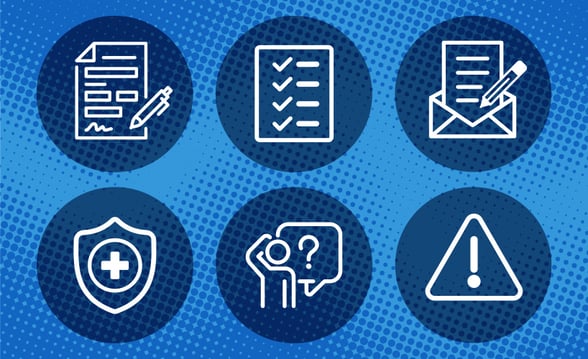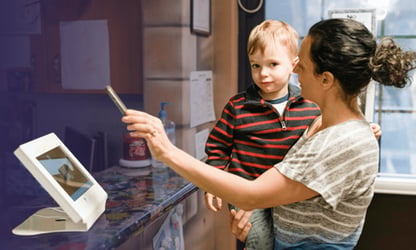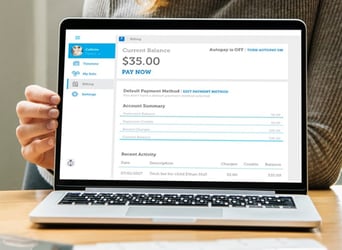
You’re probably nodding when I say that parental partnership is the cornerstone of childcare: parent-caregiver collaboration that nails family engagement in childcare and boosts that home-to-school connection.
When you tap into collaborative early education practices and parent-caregiver communication, you’re building trust with parents in childcare and fueling higher grades and test scores, according to a U.S. Department of Education study.
You champion inclusive family partnerships in preschools and support diverse families in childcare through partnership-focused childcare strategies.
Table of Contents
- The Importance of Parental Partnership in Early Childhood Education
- Key Components of Strong Parental Partnerships
- Practical Strategies to Strengthen Collaboration
- Overcoming Common Barriers to Parent-Provider Partnerships
- How Vanco Supports Parental Partnership in Child Care
- FAQs
- Final Thoughts
- 100+ Free Editable and Printable Templates to Simplify Parental Partnership
The Importance of Parental Partnership in Early Childhood Education
When you step into the world of early childhood education, it doesn’t take long to realize that parental partnership isn't just a nice-to-have; it’s the heart of everything you do. Without strong parent-caregiver collaboration, you’re just spinning your wheels.
Children thrive when you and their families work hand-in-hand, not when communication gets lost between pickup time and the weekly newsletter.
Supporting Holistic Child Development
You know better than anyone that raising a child isn’t a one-person job. That’s why family engagement in childcare matters as much as your curriculum plans. When parent-caregiver communication happens regularly (and not just during a rushed handoff at the door), you get real insights that support emotional, social and cognitive growth.
Building strong, inclusive family partnerships in preschools means you understand the child's unique background, preferences and needs and use that knowledge daily.
If you’re serious about supporting diverse families in childcare, every conversation, update and shared moment strengthens your approach. Children and their parents notice when you and their parents are genuinely a team.
Creating Consistency Between Home and Care
There’s nothing quite like a toddler getting mixed messages. (You haven’t lived until you've seen a 3-year-old passionately argue about bedtime rules.) That’s where the home-to-school connection becomes your secret weapon. You’re not just working with families in early education for appearances, you’re creating absolute consistency that makes life easier for everyone.
By encouraging strong parent-provider communication, you’re aligning goals and expectations. It’s not about forcing parents to follow your lead (or vice versa). It’s about strengthening relationships in childcare settings by listening, adapting and respecting what’s happening at home.
Building Trust and Shared Responsibility
If you’ve ever dealt with an upset parent over a mystery bruise or a missing lunchbox, you already know building trust with parents in childcare is nonnegotiable. A strong parent-caregiver communication system isn't about avoiding tough conversations, but about making sure those conversations happen in a way that feels collaborative, not confrontational.
Using tools for childcare family communication that work for your families (not just for your convenience) helps you foster transparency. That’s what partnership-focused childcare strategies look like in real life: showing up, owning mistakes, sharing wins and trusting parents as partners, not "clients."
Increasing Family Satisfaction and Program Retention
Do you want families to stick around? Do you want them to sing your praises to their friends? Then, encouraging parent participation in care settings isn’t optional; it’s the foundation. Parents want to feel involved, heard and respected. When you consistently focus on family involvement in early learning, you’re not just keeping them informed; you’re making them part of the experience.
Parent-teacher teamwork in early childhood is what builds loyalty. It's what turns nervous first-time parents into your biggest advocates. By investing in collaborative early education practices and supporting diverse families in childcare, you aren’t just helping kids succeed. You’re building a community families want to stay in, and that’s something worth celebrating.
Key Components of Strong Parental Partnerships

Creating strong parental partnerships in early education doesn’t happen by accident. You’ve probably already learned that success here depends on intentional daily effort and it’s not about checking boxes. It’s about how you build trust, how you make families feel seen and how you keep the home-to-school connection strong and consistent.
Open and Ongoing Communication
Parent-caregiver communication can be a lot. There's already a constant flow of information between drop-offs, pickups, nap logs and daily reports. But you know it’s not just about volume, it’s about quality.
You need those quick daily updates, plus newsletters that parents read, apps they don’t ignore and conferences that don’t feel like a rushed formality. Strong parent-provider communication gives families a sense of belonging, not just information. It builds confidence and shows them they’re part of a collaborative early education practice.
Tools like these newsletter templates can make your life easier. After a day of potty training and circle time, who has time to design something from scratch?
Respect for Family Culture and Values
You’ve worked with enough families to know that each one brings something unique. Creating inclusive family partnerships in preschools means making room for diverse voices, languages, traditions and parenting styles.
It’s not just about acknowledging a holiday or two. It’s how you approach curriculum decisions, how you handle conflict and how you invite feedback. Supporting diverse families in childcare starts with listening (really listening) and resisting the urge to “correct” what might be different from your norm.
This aspect is the heart of family involvement in early learning and lets parents know their values are safe with you.
Collaborative Goal Setting for Child Development
No one wants to feel like they’re being handed a checklist. When it comes to child development, parent-teacher teamwork in early childhood has to feel like, well, teamwork. You and the parents are equals in this.
Whether you’re talking about milestones, behavior patterns or learning styles, child development support is strongest when it reflects shared priorities. That’s how you create partnership-focused childcare strategies that stick.
Opportunities for Parental Involvement
If you’ve ever watched a parent tear up while reading to their child’s class, you know how robustly encouraging parent participation in care settings can be — volunteering, helping at a special event or even attending a workshop matters.
These moments are how you continue strengthening relationships in childcare settings and make the classroom feel like a community. You’re not just filling a calendar. You’re honoring the importance of family involvement in early learning and deepening that vital home-to-school connection.
Sometimes, that means finding ways to engage even the quietest families because supporting diverse families in childcare means meeting each one where they are.
Practical Strategies to Strengthen Collaboration
Create a Family Welcome Packet
You know that first impression? It matters. When a new family walks into your center, they’re sizing up more than the décor. They wonder if you value parental partnership or toss the term around during tours.
That’s why a thoughtful family welcome packet is essential. It sets the tone for inclusive family partnerships in preschools right out of the gate. You’re not just handing them a schedule and a fee chart.
You want to ensure the family feels invited to share, ask and contribute. This moment is your early chance to start building trust with parents in childcare. Don’t wait until a concern pops up. When you’re clear about routines and open to hearing how things work at home, that home-to-school connection becomes less of a buzzword and more of a lived experience.
Use Communication Logs or Digital Apps
If you're not already using communication logs or a secure app, you’re probably over-relying on memory at the end of a long day, and you know how unreliable that is.
A photo there, a quick note here, and parents feel seen. You’re showing them their child isn’t just another face in a busy room. You're modeling parent-caregiver communication in action.
This kind of transparency supports family involvement in early learning and takes the pressure off rushed pickup conversations. It’s not just convenient; it’s trust-building. It’s also one of those tools for childcare family communication you can’t skip if you're serious about supporting diverse families in childcare.
Host Family Engagement Events
Some families are hesitant at first. Maybe they’ve had poor experiences elsewhere or it’s their first child. When you host events like curriculum nights or casual parent socials, you’re extending a real invitation to be part of their child’s world outside of drop-off and pickup.
These events deepen parent-caregiver collaboration and nurture collaborative early education practices. You’re not just checking off boxes. You’re giving families a reason to show up and stay engaged. That consistent involvement helps strengthen relationships in childcare settings and reinforces partnership-focused childcare strategies.
Encourage Two-Way Feedback
Here’s the thing: feedback shouldn’t feel like a formal complaint system. Make it easy and normal. Set up anonymous suggestion boxes or quick surveys. Better yet, create space for casual one-on-one check-ins. This tip fosters parent-teacher teamwork in early childhood without making it feel like a chore.
By encouraging parent-caregiver communication regularly and with sincerity, you’re reinforcing that this is a true parental partnership, not just a service you provide. When families know they’re heard, they’re far more likely to stay involved. Isn’t that what working with families in early education is all about?
Overcoming Common Barriers to Parent-Provider Partnerships
Even with the best intentions, creating strong parent-caregiver communication and family engagement in childcare can feel like an uphill climb. If you’ve ever stared at an unread email to a parent for the third time in a week, you’re not alone.
Let’s get real about some of the biggest challenges you face in working with families in early education and how understanding them can make your parent-caregiver collaboration stronger.
Time Constraints and Busy Schedules
You see it daily: families sprinting from work to daycare pickups, juggling dinner, homework and bedtime chaos. Making time for parent-provider communication feels impossible. The truth is, family involvement in early learning competes with 100 other priorities.
It’s not that families don’t want to connect; it's that squeezing in another conversation feels overwhelming. You must be ready to meet them where they are, with realistic expectations that honor both sides of the home-to-school connection.
Language and Cultural Differences
This one hits hard when you're working with families from diverse backgrounds. You know that supporting diverse families in childcare isn’t just about translating flyers; it’s about tuning into how different cultures view:
- Learning
- Behavior
- Day-to-day routines
Sometimes, you’ll feel the disconnect even when everyone’s trying their best. Yes, inclusive family partnerships in preschools sound lovely, but they don’t happen by accident. You notice when families are hesitant or unsure of what’s expected. It’s not a lack of care; it’s often a lack of cultural comfort.
Miscommunication or Mismatched Expectations
You’ve likely had at least one moment where you thought a family was ignoring your notes, only to find out they didn’t even understand what you were asking. Parent-caregiver communication breaks down when you assume you’re on the same page.
That’s why tools for childcare family communication can feel both essential and frustrating, especially when parents don’t use them the way you expected. You’re working hard on partnership-focused childcare strategies, but sometimes, the feedback loop doesn’t close. That’s not failure, it’s part of the process.
Building Trust with New Families
When a new family walks through your doors, trust isn’t automatic. You earn it slowly. Building trust with parents in childcare happens when you show up consistently, communicate transparently and create real opportunities for encouraging parent participation in care settings.
New families are susceptible to how you prioritize parent-provider communication and whether they feel part of the partnership-focused childcare strategies you use daily.
Actual family involvement in early learning isn’t a check box. It’s something you cultivate every day through moments, conversations and lots of patience, no matter how hectic life gets.
How Vanco Supports Parental Partnership in Childcare
Tools for Secure and Easy Communication with Families
A strong parental partnership doesn’t just happen because you care; it takes intention, tools and time, which are scarce. That’s where Vanco steps in, making it easier for you to strengthen inclusive family partnerships in preschools without adding stress to your already busy day.
With secure, easy-to-use communication tools, you’re not stuck chasing texts or wondering if a parent saw that note in the diaper bag. Our tools keep parent-caregiver communication flowing clearly, which makes supporting diverse families in childcare much more manageable—the more seamless the messages, the stronger the home-to-school connection.
Streamlined Tuition and Payment Management
Tuition doesn’t have to be the awkward part of the conversation, either. Vanco’s billing and payment software lets parents pay on their schedules while you stay focused on what matters: strengthening relationships in childcare settings, not spreadsheets.
Helping Providers Focus on Building Connections, Not Paperwork
With less time spent juggling logistics, you can invest more in parent-teacher teamwork in early childhood and family involvement in early learning. That’s where the real impact happens: when you’re free to focus on collaborative early education practices instead of endless admin. Because real parent-caregiver collaboration should feel natural, not forced.
FAQs
What are the benefits of strong parent-provider partnerships?
In early childhood, you get better child development support, smoother parent-caregiver communication and real parent-teacher teamwork. Plus, stronger inclusive family partnerships in preschools help kids feel secure.
How can I improve communication with non-English speaking families?
Use translation tools, but also lean into genuine parent-caregiver collaboration and open home-to-school connection practices.
What tools help childcare centers build parental partnerships?
Vanco is reliable and so is ClassDojo. These tools are excellent for supporting diverse families in childcare. It also simplifies tools for childcare family communication.
How involved should parents be in the day-to-day program?
Very. Family involvement in early learning isn’t optional; it’s how you build trust with parents in childcare.
How do I respectfully include diverse family cultures in our program?
Start with listening. Encouraging parent participation in care settings builds partnership-focused childcare strategies naturally.
Final Thoughts
When you focus on inclusive family partnerships in preschools, you’re not just checking a box. You’re actively strengthening relationships in childcare settings. You already know how crucial parent-caregiver communication is, especially when Monday mornings are chaotic and toddlers have strong opinions on socks.
That ongoing home-to-school connection makes all the difference. Whether navigating parent-teacher teamwork in early childhood or simply encouraging family involvement in early learning, you’re creating something sustainable. So keep embracing collaborative early education practices; your effort builds trust, supports families and keeps everyone growing forward.
100+ Free Editable and Printable Templates to Simplify Parental Partnership
We've prepared something special for you — 100+ user-friendly templates to make your essential work easier. Because the work you do with children matters so very much, and you deserve the tools you need.
Get the Full Collection with Just 4 Simple Steps: Assembly Required (0 Minutes)
Step 1: Click the button
Step 2: Download 100+ ready-to-use templates
Step 3: Implement immediately
Step 4: Experience efficient childcare management













